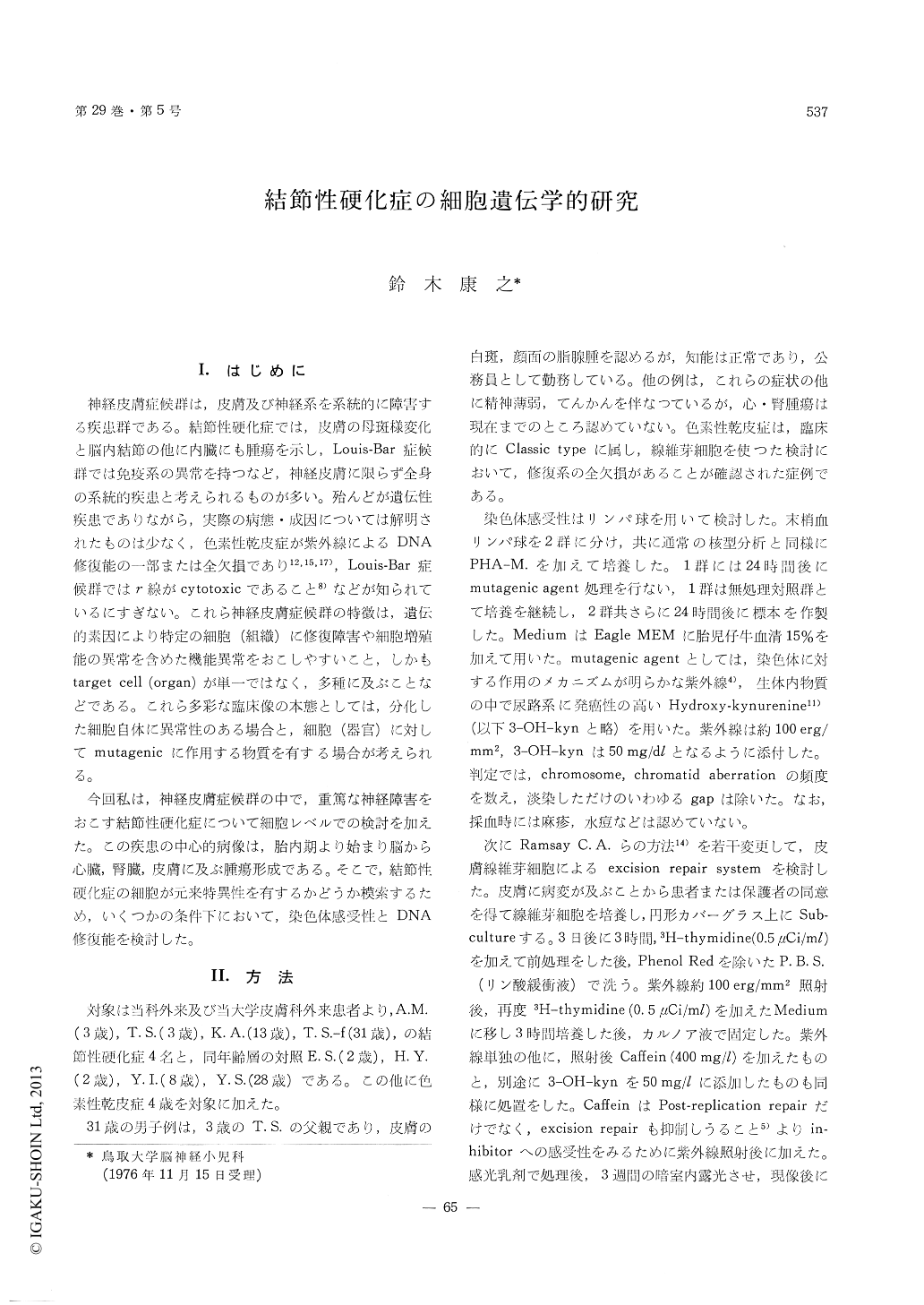Japanese
English
- 有料閲覧
- Abstract 文献概要
- 1ページ目 Look Inside
I.はじめに
神経皮膚症候群は,皮膚及び神経系を系統的に障害する疾患群である。結節性硬化症では,皮膚の母斑様変化と脳内結節の他に内臓にも腫瘍を示し,Louis-Bar症候群では免疫系の異常を持つなど,神経皮膚に限らず全身の系統的疾患と考えられるものが多い。殆んどが遺伝性疾患でありながら,実際の病態・成因については解明されたものは少なく,色素性乾皮症が紫外線によるDNA修復能の一部または全欠損であり12,15,17),Louis-Bar症候群ではr線がcytotoxicであること8)などが知られているにすぎない。これら神経皮膚症候群の特微は,遺伝的素因により特定の細胞(組織)に修復障害や細胞増殖能の異常を含めた機能異常をおこしやすいこと,しかもtarget cell (organ)が単一ではなく,多種に及ぶことなどである。これら多彩な臨床像の本態としては,分化した細胞自体に異常性のある場合と,細胞(器官)に対してmutagenicに作用する物質を有する場合が考えられる。
今回私は,神経皮膚症候群の中で,重篤な神経障害をおこす結節性硬化症について細胞レベルでの検討を加えた。この疾患の中心的病像は,胎内期より始まり脳から心臓,腎臓,皮膚に及ぶ腫瘍形成である。そこで,結節性硬化症の細胞が元来特異性を有するかどうか模索するため,いくつかの条件下において,染色体感受性とDNA修復能を検討した。
Tuberous sclerosis has been regarded as a geneticaldevelopmental anomaly with tumorigenicity, butthe underlying cause of the disease is entirelyunknown. Investigation on genesis of the tumori-genicity has not been reported. In order to obtainsome insight into the etiology of tuberous sclerosis,the chromosome structure and some functions ofcultured cells were studied.
1) Chromosome analysis of lymphocytes wasmade after 48-houre-culture. High incidence ofchromosomal or chromatid breakage was found inthe cells from the patients with tuberous sclerosis.The incidence of the cells with the aberration was21 of 503 cells from 6 cases aged 3 to 31 withtuberous sclerosis while 4 of 400 cells from theage-matched control. The numbers of the abnormalcells tended to increase with advancing age of thepatients. An adult patient aged 31 showed rarechromatid interchanges in 3% of cells; one triradialfigure and two quadriradial figures. The incidenceof the complex aberrations and rearrangement maybe related to the tumorigenicity of tuberous scle-rosis.
2) Chromosomal breakage derived from DNAdeletion. DNA sensitivity to mutagens was ex-amined by observing chromosomal aberrations afterUV-irradiation or adding 3-Hydroxy-kynurenineinto the culture medium which is tumorigenicagent to urinary organs. No difference was detectedbetween the tuberous sclerosis and control cells inthe occurrence of either chromosomal or chromatidaberrations. No specific breaking point in eachchromosome of tuberous sclerosis was identified.
The excision repair which is the main constituentof repairing system was examined by autoradio-graphy for cultured fibroblasts. Un-scheduled DNAsynthesis was seen after UV-irradiation in fibro-blasts from both normal control and tuberoussclerosis, but not from xeroderma pigmentosum.These results may indicate that the cells of tube-rous sclerosis have a susceptibility to chromosomalaberration in advanced case, but almost normalrepairing activity in the excision repair system.
3) Some problems concerning the tumorigenicityin tuberous sclerosis were discussed. If it has beencaused in an early embryonic phase, "tumors"should appear in infancy or in early childhood;tumorigenicity means unusual capacity of growingbeyond that of common cells. Some patients haverhabdomyoma and brain sclerosis at birth whilesome patients developmental tumor in adulthood.These facts cannot be explained by only the con-cept of developmental anomaly. It is assumed thatthe cells of tuberous sclerosis should be mutableat any time. Based on the clinical and pathologicalfindings some investigators suspected the disease tohave abnormal protein or nucleic acid metabolism.The chromosomal aberration of lymphocytes as ob-served in this study may suggest the presence ofa disorder of nucleic acid metabolism, if not sothere could be some abnormal agents bringingabout chromosomal aberrations.

Copyright © 1977, Igaku-Shoin Ltd. All rights reserved.


